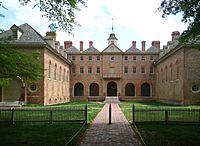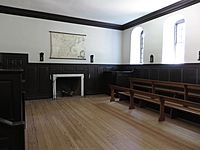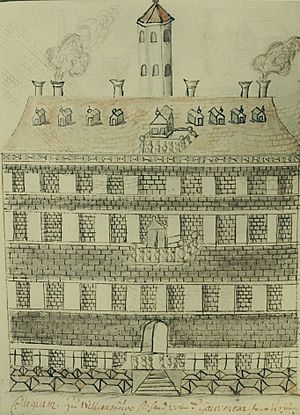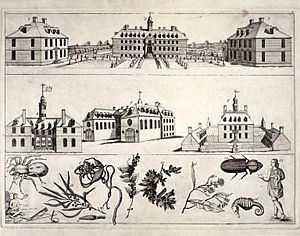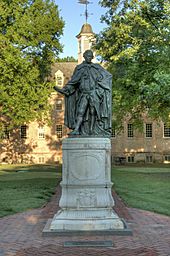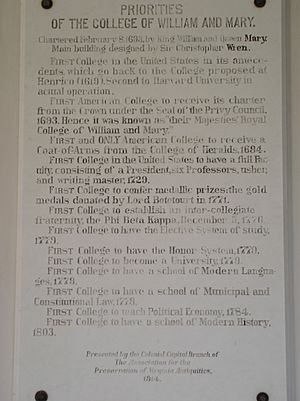Wren Building facts for kids
|
Wren Building, College of William and Mary
|
|
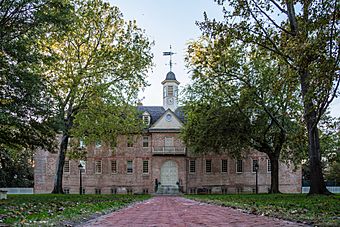
The front of the Wren Building
|
|
| Location | Williamsburg, Virginia |
|---|---|
| Built | 1700 |
| Architectural style | Renaissance |
| NRHP reference No. | 66000929 |
Quick facts for kids Significant dates |
|
| Added to NRHP | October 15, 1966 |
| Designated NHL | October 9, 1960 |
The Wren Building is a very important and famous building. It stands at the College of William & Mary in Williamsburg, Virginia, USA. This building, along with the Brafferton and President's House, makes up the College's historic "Ancient Campus."
It is the oldest school building in the United States that has been used continuously. Its construction started way back in 1695. Because of its long history, it was named a National Historic Landmark in 1960.
Contents
A Look Back: The Wren Building's History
The first part of the Wren Building was started on August 8, 1695. It was finished by the year 1700. Over the years, the building faced several fires and had to be rebuilt.
After the 1920s, a man named John D. Rockefeller, Jr. helped restore it. He worked with Reverend Dr. W.A.R. Goodwin to bring back the old look of Colonial Williamsburg. The building you see today was restored by architects from Boston, Perry Shaw & Hepburn. They made it look like it did between 1716 and 1859.
The College named the building after a famous English architect, Sir Christopher Wren. A professor named Hugh Jones wrote in 1724 that Sir Christopher Wren designed it. However, no one knows for sure how Jones knew this. There are no documents that connect Sir Christopher Wren to the building's design. He never even came to North America!
What is the Wren Building Made Of?
The building is made of red brick. It uses a special brick pattern called Flemish and English Bond. This was a common style for important buildings in Williamsburg during the 1600s and 1700s.
Inside, the Wren Building has classrooms and offices. It also has a large dining hall called the Great Hall. There's a kitchen and a chapel, which was added in 1732. Underneath the chapel is a crypt. Important people from Virginia's past are buried there. These include Governor Norborne Berkeley, 4th Baron Botetourt and Peyton Randolph, who was the first leader of the Continental Congress.
On top of the building, there is a weather vane with the number 1693. This is the year the College was founded. In the 1770s, there were plans to make the building into a square shape. Thomas Jefferson, who went to the College, even drew up a plan. But the American Revolutionary War stopped the building work. The fourth side was never finished, but its foundations are still there.
You can still visit the first and second floors of the Wren Building today. Student groups called the Spotswood Society offer tours when classes are in session. You can also learn more about the building through their virtual tour.
How Was the Wren Building Used?
The Wren Building is the oldest building in the United States built for a college. For a long time, it was the only main building for the College. Students lived, studied, and attended church services there.
A Meeting Place for Leaders
When Virginia's old capital, Jamestown, was destroyed, the state's government needed a new place to meet. From 1700 to 1704, Virginia's lawmakers, called the House of Burgesses, met in the Wren Building's Great Hall. This happened while a new building, the Capitol, was being built.
The College was very important in making Williamsburg the new capital. In 1699, William & Mary students even gave speeches. They promised to help build the town. When the Capitol burned down in 1747, the lawmakers moved back into the Wren Building. They stayed there until the Capitol was rebuilt in 1754.
The building also had a grammar school and a school for Native American students. The Native American school later moved to the Brafferton building in 1723. During the American Revolutionary War, the French military used the Wren Building as a hospital. Later, during the American Civil War, the Confederacy also used it as a military hospital.
Traditions and Ceremonies Today
Today, the Wren Building is used for classes, but it also has special historical meaning. It's used for important ceremonies. Each year, new students walk through the building from one side to the other during a special welcome ceremony. When they are about to graduate, they walk through it in the opposite direction.
The College's holiday celebration, the Yule Log Ceremony, happens at the Wren Building every December. New students also take their school's Honor Code Pledge in the Great Hall each fall.
The Historic Setting of the College
After the President's House and the chapel wing were finished in 1732, the College's layout stayed mostly the same for about 150 years. The campus had three main buildings: the Wren Building, the Brafferton, and the President's House. They were arranged in a balanced way in the College yard. The Wren Building was in the middle, with the Brafferton to the south and the President's House to the north. This arrangement showed balance and order, which were important ideas at the time.
To make the view even better, a formal garden was created in the front of the College yard. It had hedges, shaped bushes, and flower beds. In the back, there was a garden for plants and science, leading to forests and streams.
Over time, the front garden changed. By the late 1700s, it was gone. Later pictures from the 1800s show rows of trees and even cows in the College yard. Any last signs of the gardens were destroyed in 1862 during the Siege of Williamsburg.
For a long time, there were not many descriptions of what the College grounds looked like. But in the late 1920s, researchers found an old printing plate in England. This "Bodleian Plate," from around 1747, showed Williamsburg landmarks, including the College. This plate was used as a guide when the Wren Building was restored in the 1920s and 1930s.
At first, people weren't sure if the plate was accurate about the gardens. But when College archaeologists started digging in 2005, they found evidence. The Bodleian Plate turned out to be very accurate in showing the early garden layout. Even though the two side buildings are not perfectly balanced, the College's design was very impressive for people in the 1700s.
Fires and Rebuilding
The Wren Building has been badly damaged by fire three times. These fires happened in 1705, 1859, and 1862.
The first fire in 1705 was an accident. It started in a basement room. Governor Alexander Spotswood ordered the rebuilding, which was finished by 1716. Some money for the rebuilding came from Queen Anne.
A second fire destroyed much of the building in 1859. When it was rebuilt, the Wren Building had a new, popular design called Italianate. The third fire was started on purpose by Federal troops during the Civil War in 1862. Each time the building was rebuilt, the old outer walls were used. However, the overall look of the building changed quite a bit over the years.
Sir John Randolph, an important lawyer and government leader in colonial Virginia, was buried in the chapel's crypt after he died in 1737. After the 1859 fire, his burial place was disturbed. A doctor looked at the tomb and found the bones of Sir John Randolph and another unknown person.
The Botetourt Statue
A popular Virginia Governor named Norborne Berkeley, 4th Baron Botetourt, also known as Lord Botetourt, died in 1770. He was buried in the crypt under the building's chapel.
In 1797, the College of William and Mary got a statue of Lord Botetourt. It was moved to the campus from the old Capitol building in 1801. For many years, this statue stood in front of the Wren Building. It was a well-known landmark.
After years of being outside, the original statue was moved indoors in 1958. In 1966, it was placed in the College's Swem Library. In 1993, when the College celebrated its 300th anniversary, a new bronze statue of Lord Botetourt was put in the College Yard. This new statue was made by a William and Mary graduate named Gordon Kray.
Important "Firsts" for the College
In 1914, a large plaque was given to the College by the Association for the Preservation of Virginia Antiquities. This plaque lists some of the amazing "firsts" that happened at William and Mary:
- First college in the United States. Some say its history goes back to a college planned in Henrico in 1619.
- First American college to get its official permission from the King and Queen of England in 1693. This is why it was called "their Majesties' Royal College of William and Mary."
- First and only American college to get a special Coat-of-Arms from London in 1694.
- First college in the United States to have a full group of teachers, including a President and six Professors, in 1729.
- First college to give out medal prizes. Lord Botetourt donated gold medals in 1771.
- First college to start a national student club, the Phi Beta Kappa, on December 5, 1776.
- First college to let students choose their own classes in 1779.
- First college to have an Honor System, which was written by Thomas Jefferson in 1779.
- First college to become a University in 1779.
- First college to have a school for Modern Languages in 1779.
- First college to include Fine Arts as part of a professorship in 1779.
- First college to have a school for Law in 1779.
- First college to teach Political Economy (the study of how governments and economies work) in 1784.
- First college to have a school for Modern History in 1803.
Images for kids




